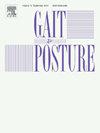Anticipatory muscle activations to coordinate balance and movement during motor transitions: A narrative review
IF 2.2
3区 医学
Q3 NEUROSCIENCES
引用次数: 0
Abstract
Background
Maintaining balance while moving is vital for day-to-day activities. A key challenge in the comprehension of human movement is to determine how muscles contribute to balance-movement coordination. Motor transitions, defined as movements executed between two steady balance states, are particularly interesting phases to study balance-movement coordination because a large, discrete change in whole-body momentum may disturb balance. During voluntarily-initiated motor transitions, anticipatory muscle patterns provide the biomechanical conditions that are favourable to both maintaining balance and executing the movement.
Research question
What are the mechanical consequences of anticipatory muscle activations for balance-movement coordination during voluntarily-initiated motor transitions?
Methods
We review the biomechanical contributions of the anticipatory muscle activations identified in the literature during four types of voluntarily-initiated motor transitions, through the prism of three balance mechanisms (‘moving the centre of pressure (CoP)’, ‘counter-rotating segments’, and ‘applying new external force(s)’). In particular, we investigate how anticipatory muscle activations modulate whole-body centre of mass acceleration.
Results
We show that the mechanical consequences of anticipatory muscle activations have been extensively described, but mainly using the ‘moving the CoP’ mechanism. Unlike their role during steady balance states, both ‘moving the CoP’ and ‘applying new external force(s)’ mechanisms create a required mechanical instability during the anticipatory phase of motor transitions. The ‘counter-rotating’ mechanism may act as a stabiliser during motor transitions, but additional research is needed to clarify this assumption.
Significance
This review establishes that muscle activation processes have different mechanical consequences for balance-movement coordination during the anticipatory phases of motor transitions, compared to steady balance states. Because the mechanical instability that is created can lead to falls, a better understanding of the mechanisms underlying motor transitions is needed to enable the design of more effective fall prevention programs and/or devices for population with balance deficits.
求助全文
约1分钟内获得全文
求助全文
来源期刊

Gait & posture
医学-神经科学
CiteScore
4.70
自引率
12.50%
发文量
616
审稿时长
6 months
期刊介绍:
Gait & Posture is a vehicle for the publication of up-to-date basic and clinical research on all aspects of locomotion and balance.
The topics covered include: Techniques for the measurement of gait and posture, and the standardization of results presentation; Studies of normal and pathological gait; Treatment of gait and postural abnormalities; Biomechanical and theoretical approaches to gait and posture; Mathematical models of joint and muscle mechanics; Neurological and musculoskeletal function in gait and posture; The evolution of upright posture and bipedal locomotion; Adaptations of carrying loads, walking on uneven surfaces, climbing stairs etc; spinal biomechanics only if they are directly related to gait and/or posture and are of general interest to our readers; The effect of aging and development on gait and posture; Psychological and cultural aspects of gait; Patient education.
 求助内容:
求助内容: 应助结果提醒方式:
应助结果提醒方式:


